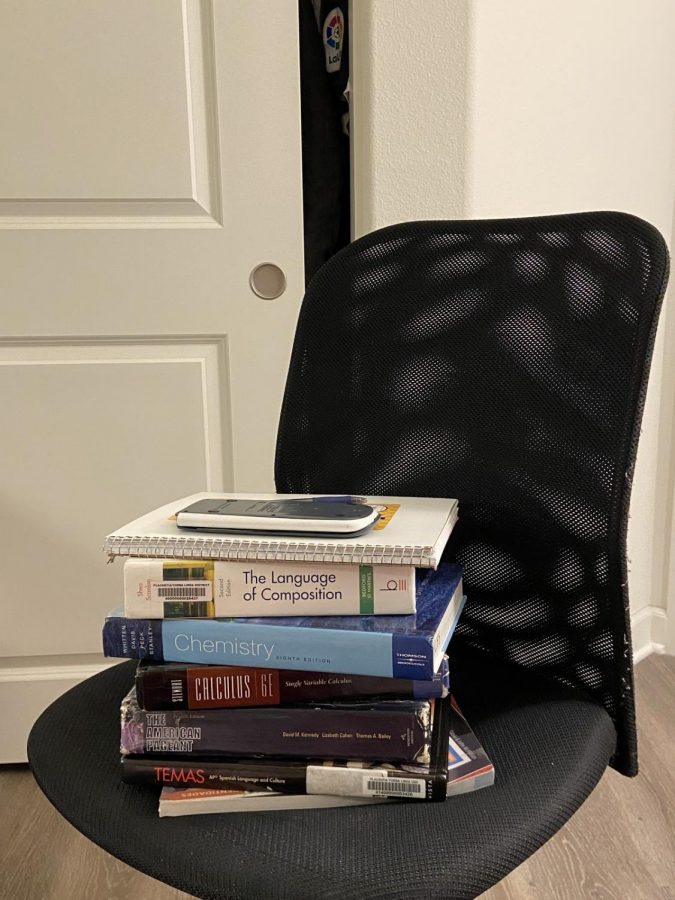Can Distance Learning Worsen School Performance?
Distance learning has merged the bedroom and the classroom into one. But could this have consequences for students in their school performance?
February 2, 2021
There’s no doubt that distance learning offers students an unbridled convenience that cannot be matched by in-person learning. In the midst of a pandemic, the cost and time of transit to school disappears as a simple click on the Zoom app opens up the online classroom. Rather than preparing meals the night before or queuing in the cafeteria at lunchtime, most students have the kitchen a short trip downstairs or a few feet away. However, while online students enjoy such convenience at home, learning digitally rather than in-person may have negative effects on school performance.
One thing is for sure: online learning has drastically increased students’ screen time. According to Yorba Linda High School’s hybrid schedule, periods one through six are a combined 305 minutes (nearly 5 hours). And that isn’t counting zero or seventh period, which each stack on fifty minutes. Pre-pandemic, these five hours would have been spent in school in a physical classroom, whereas now students are forced to undergo five hours at home staring at a screen to attend class. Added onto further screen time spent on recreation and homework, the sheer weight of the added hours online just to attend school is exhausting, as, according to insider.com, too much screen time can lead to behavior problems, obesity, difficulty sleeping, and back and neck problems.
Further, online learning prevents the personal interactions between teachers, students, and peers. Reduced interactions between peers can also negatively affect motivation and behavior. Joyce Lin (11) feels that, due to distance learning, her school performance has gotten worse. “With distance learning, I have to stare at my computer screen for at least 6 hours every day,” she explains. “This really tired me out. Also, without interactions with peers, the school has been really boring and I lack the motivation to study for anything.”
Reduced interactions with teachers have their effects as well. Teachers have fewer opportunities to motivate their students and develop personal connections when lecturing through a screen. Online learning also reduces the capabilities of teachers to offer direct assistance and detailed explanations to their students, which can lead to worse performances than in-person learning.
In addition, the technology aspect presents another issue. Students and teachers can be prone to issues with technology managing the online meeting. Meaning, both parties must be tech-savvy enough to handle digital conference platforms. Such dependence on technology means that, as a result, a short power outage or even a glitch can completely ruin the day’s important lesson.
Academic honesty is another issue of distance learning that cannot go unmentioned. Proctoring only through webcams, teachers have found it even more difficult to detect students sharing or searching up answers online. This dip in academic integrity may have also been incensed by difficulties to absorb information thoroughly in online lessons, leading students to feel more inclined to cheat.
In the end, while distance learning presents undeniable convenience for its students, it simply cannot suffice as a proper substitute to in-person education. However, in such a unique era of the coronavirus, students, teachers, and parents alike will just have to bear its effects until the pandemic’s situation improves and the nation can return to normal.






































Emma Perron • Feb 28, 2021 at 12:01 PM
I believe online school has pros and cons. It is also better from some people than others, I personally have a hard time staying focused and doing work. Other people work harder and are doing better in school. You showed both sides and I love that. You did a great job.
Emma Perron • Feb 14, 2021 at 10:09 PM
I love this article, You explain the benefits of staying at home and at being at school. Being at home is hard for a lot of people and most people do not do a lot of work. You wrote a wonderful article.
danielle huizar • Feb 11, 2021 at 8:00 AM
This is a great article and an important topic to talk about. In my opinion, online school is decreasing my motivation, and I agree that more screen time is having multiple adverse effects. I like how you included the effects of online school as teachers as well.
Anita Tun • Feb 7, 2021 at 11:44 AM
Online school has defiantly changed the way I learn, but I think that are a lot of positives with distance learning, but also a lot of negatives to it as well. It all depends on the person and their situation too.
faith desio • Feb 7, 2021 at 8:51 AM
Great article! I think that distance learning comes with its ups and downs and is not always the easiest. But, I know that the teachers are trying their hardest to give us the best experience possible in these hard times!
Katelyn Ruggles • Feb 6, 2021 at 10:47 PM
I agree with your point on online learning decreasing students learning. I think with the tough times we are in, it is especially harder for students to be motivated, more so with all the distractions at home.
Suhani Bhanvadia • Feb 6, 2021 at 5:40 PM
I completely agree that online school has had a negative impact on student’s learning, but I also think people should stop using it as an excuse for everything. Of course, some things are understandable but we’ve been doing this for a while so I think students should be used to it by now.
Paige Reddick • Feb 5, 2021 at 12:17 AM
This is a great article, Sharon. I have talked to many friends who have suffered from distance learning. I hope that distance learning does not have to last for much longer. Thank you for explaining its effects.